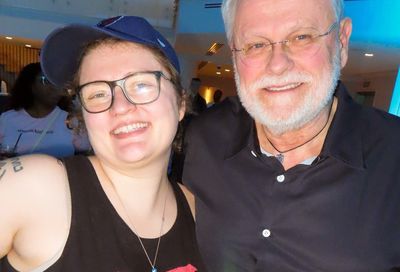The Next Wave: COVID-19 could come back “with a vengeance” this fall
Researchers warn that the U.S. needs to get ahead of the curve before a possible second wave of COVID-19 infections hit
By André Hereford on April 23, 2020 @here4andre

While politicians and the public debate when, where, and how our communities should relax social distancing and “liberate” the economy, the coronavirus itself marches on unfazed by tweets or demonstrations. The U.S. continues to lead the world in new cases of infections, and the death toll from COVID-19 keeps rising at a rate of more than 1,000 Americans per day.
Lockdowns are helping to limit the spread of the virus, but COVID cases are surging in states from Maryland and Pennsylvania to Iowa and Wisconsin. Even as tension mounts among a populace growing restless sheltering in place, leading scientists and clinicians like Dr. Thomas J. Hope, of Northwestern University’s Hope Laboratory in Chicago, are still working to determine whether this virus is especially contagious. “Or,” as Hope ponders, “is this what any of these viruses would look like if there was no preexisting immunity?”
“Regular flu can transmit this easily,” he says. “But we usually don’t see it because you have either a good preexisting immunity and you never get any symptoms, or you have enough immunity that you’re not starting from scratch when you respond.” Hope predicts that before all is said and done, we’ll know more about the transmissibility of this coronavirus, “but right now I don’t think we can answer that question.”
In search of answers, the virologist, dedicated for decades to HIV research and prevention science, has thrown his lab at the problem of studying this coronavirus. “I’m not a vaccine maker or a drug finder, but I try to just understand how things work. And I think we really have no idea how this damn thing works,” he says.
Mysteries abound, for instance, around how COVID-19 affects the body’s organs. “We think about it in the lungs, but it’s causing heart attacks and problems with diabetes and kidney failure and liver problems and all this stuff,” Hope says. “What they don’t know is are all those problems because the virus is going there, or are those problems because of hypoxia? If you’re not getting enough oxygen, your body starts to say, ‘Okay, if we’ve got to get rid of something, let’s get rid of these kidneys first. Maybe we have a chance. Otherwise, no chance.’ So we don’t yet know how this is all working. With my methods, I should be able to go right after the action.”
The Hope Laboratory is one of dozens throughout the U.S. bringing their expertise to the fight against this pandemic. In nearby Madison, Wisconsin, Dr. Dave O’Connor’s lab at the University of Wisconsin is also attacking the problem, similarly applying methods and experience honed through years of studying HIV/AIDS. “I’m an HIV researcher first and foremost. That’s how I identify,” says O’Connor. “Most of my way of thinking is informed by my involvement in the response to HIV, and that includes the work that we’ve done on emerging viruses over the last decade or so.”
O’Connor’s lab is focused on another critical component of combating coronavirus: trying to come up with better ways of testing for it. “You’ve seen that there are shortages of supplies, there are shortages of the nasal swabs,” he says. “So we’ve been working with some local biotech companies to try to come up with clever alternative ways to do some of the testing in ways that would expand the supply chain.”
The redesigned tests would produce the same result, O’Connor says, “but do it in a way that allows you to use different types of reagents and chemicals. Instead of using nasal swabs, which are running low, use saliva. So we’re thinking about different ways of expanding access to testing by using different approaches.”
Testing — and creating testing that’s functional, accessible, and affordable — has been and continues to be a highly contentious issue. As O’Connor notes, “People can say as much as they want that testing is available to everyone who needs it, but I bet you’d be able to find hundreds and thousands of people for whom that was not their experience.” Yet he also notes that even if the scale of available testing were to match the demand, “That’s going to be a big challenge. And even if we could do that in the sense that there’s people and instrumentation and automation that can make that happen, is there going to be money to pay for it? Who is going to pay for it?
“If you make that the responsibility of every person to get their own testing, you’re just going to perpetuate some of the health inequalities that are going to continue to affect some of the most marginalized and stigmatized populations, and that’s something that I think we need to be really, really worried about.”
Regardless of cost or scale, though, testing will play a key role in deciding the debate about when life, work, and play can get back to normal. Just ask House Speaker Nancy Pelosi, who told ABC News, “The key to reopening the economy is testing, testing, testing.”
Another key would be a vaccine or proven treatment — but the world still waits. And without adequate testing on a mass scale, along with the contact tracing that would allow, scientists caution that relaxing social distancing too soon, and sending people back to work, stores, bars and restaurants, could trigger a deadly surge in coronavirus cases.
“People are already talking about a second wave before the first wave is done,” observes Hope, drawing comparisons between the current coronavirus outbreak and the 1918 flu pandemic that struck in three lethal waves within less than ten months. The second wave was, by far, the worst.
“This, I think, is definitely going to happen: this fall it’s going to come with a vengeance,” says Hope. “And instead of starting in one place — Wuhan, China — and spreading around the world as quickly as it did, when the environmental conditions get better for the virus and we enter the flu season, it’s going to be like a thousand Wuhans releasing [the] virus at the same time.”
O’Connor likewise warns that the fall flu season might bring a devastating resurgence of the virus, but he also foresees science and medicine stepping up to mitigate the problem. “I don’t want to be overly pessimistic,” he says. “I think that it is likely that between now and the fall you will discover that there are going to be some therapeutic products that will help. I don’t believe they’ll be cures, but I believe that they will help minimize the severity of disease in hospitalized patients. I think we will gain some operational experience in terms of how best to manage patients who are hospitalized and who are really sick, and I think that all of this will help minimize the impact of a fall wave.
“But I think we also need to be braced for the possibility that this might be the appetizer to a fall wave main course, and that fall wave might be much, much worse and much, much longer in duration than what we’re experiencing now. I hope I’m wrong. But I think we need to be preparing for that.”
Both O’Connor and Hope insist that the best preparation for any of us is to be armed with accurate knowledge about what you can do to protect yourself and others. Hope makes a point of putting good information out there, he says, in order to fight against misinformation — like a purported coronavirus home cure someone sent him on Facebook. “It was amazing, right? ‘Take your hair dryer on the lowest setting and blow it up your nose because the virus doesn’t like heat.’ Are you kidding me? And people keep sending me all these things about gargling with vinegar. And I just keep saying, ‘No. No, no, no. If that makes you feel better, do it, but don’t think it’s going to keep you from getting infected.'”
Understandably, the fear of contagion and the distress of confinement, along with the grief and anger fueled by loss and financial pain, have led some to desperation. But we have so much more than just hunches and home cures on our side to fight this disease.
“We’re not at the virus’ mercy,” O’Connor insists. “We are living with the virus, just as people living with HIV are living with HIV. They’re not defined by their virus. They are people who happened to be infected. We are a society and a community that happens to be experiencing this epidemic. I think what that means is we need to be mindful of that. We need to understand what the ramifications are, but we need to figure out how to move past it so that the virus doesn’t define us. We have a lot of power individually and collectively. We just need to work together to try to use it as effectively as we can to move forward as well as we can.”
Support Metro Weekly’s Journalism
These are challenging times for news organizations. And yet it’s crucial we stay active and provide vital resources and information to both our local readers and the world. So won’t you please take a moment and consider supporting Metro Weekly with a membership? For as little as $5 a month, you can help ensure Metro Weekly magazine and MetroWeekly.com remain free, viable resources as we provide the best, most diverse, culturally-resonant LGBTQ coverage in both the D.C. region and around the world. Memberships come with exclusive perks and discounts, your own personal digital delivery of each week’s magazine (and an archive), access to our Member's Lounge when it launches this fall, and exclusive members-only items like Metro Weekly Membership Mugs and Tote Bags! Check out all our membership levels here and please join us today!
The Magazine
-
Most Popular
 Hugh Bonneville Talks 'Downton Abbey,' 'Paddington,' and 'Vanya'
Hugh Bonneville Talks 'Downton Abbey,' 'Paddington,' and 'Vanya'  Gay Army Reserve Officer in Uniform Sex Video Scandal
Gay Army Reserve Officer in Uniform Sex Video Scandal  Signature Honors Mandy Patinkin in Emotional Celebration
Signature Honors Mandy Patinkin in Emotional Celebration  A Potent (and Pricey) 'Good Night, And Good Luck'
A Potent (and Pricey) 'Good Night, And Good Luck'  Ex-Mormon Josiah Ryan Spreads Love as 'Gay Jesus' in Utah
Ex-Mormon Josiah Ryan Spreads Love as 'Gay Jesus' in Utah  'The Wedding Banquet' Remake Serves Laughter and Love
'The Wedding Banquet' Remake Serves Laughter and Love  Holly Twyford and Kate Eastwood Norris Shine in 'Bad Books'
Holly Twyford and Kate Eastwood Norris Shine in 'Bad Books'  Gallery: Blake Little's Breathtaking 'Construction Nudes'
Gallery: Blake Little's Breathtaking 'Construction Nudes'  Jared Polis Signs Law Repealing Colorado's Gay Marriage Ban
Jared Polis Signs Law Repealing Colorado's Gay Marriage Ban  Hugh Bonneville Delivers a Show-Stopping Vanya
Hugh Bonneville Delivers a Show-Stopping Vanya
 Hugh Bonneville Talks 'Downton Abbey,' 'Paddington,' and 'Vanya'
Hugh Bonneville Talks 'Downton Abbey,' 'Paddington,' and 'Vanya'  Holly Twyford and Kate Eastwood Norris Shine in 'Bad Books'
Holly Twyford and Kate Eastwood Norris Shine in 'Bad Books'  'The Wedding Banquet' Remake Serves Laughter and Love
'The Wedding Banquet' Remake Serves Laughter and Love  Ex-Mormon Josiah Ryan Spreads Love as 'Gay Jesus' in Utah
Ex-Mormon Josiah Ryan Spreads Love as 'Gay Jesus' in Utah  Gallery: Blake Little's Breathtaking 'Construction Nudes'
Gallery: Blake Little's Breathtaking 'Construction Nudes'  Becca Balint: The Pride of Vermont
Becca Balint: The Pride of Vermont  Signature Honors Mandy Patinkin in Emotional Celebration
Signature Honors Mandy Patinkin in Emotional Celebration  MISTR's Free DoxyPEP Leads to Huge Drop in STI Rates
MISTR's Free DoxyPEP Leads to Huge Drop in STI Rates  A Potent (and Pricey) 'Good Night, And Good Luck'
A Potent (and Pricey) 'Good Night, And Good Luck'  Sarah Snook is Astonishing in Broadway's 'Dorian Gray'
Sarah Snook is Astonishing in Broadway's 'Dorian Gray'
Scene
Metro Weekly
Washington's LGBTQ Magazine
P.O. Box 11559
Washington, DC 20008 (202) 638-6830
About Us pageFollow Us:
· Facebook
· Twitter
· Flipboard
· YouTube
· Instagram
· RSS News | RSS SceneArchives
Copyright ©2024 Jansi LLC.









You must be logged in to post a comment.